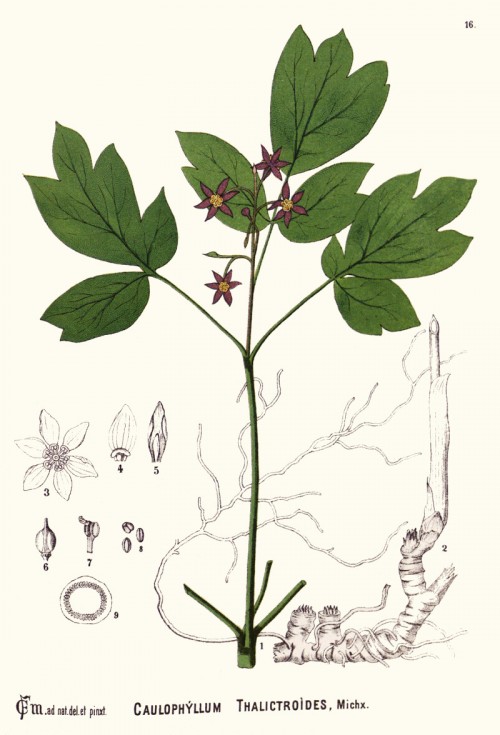Dies ist eine alte Version des Dokuments!
Caulophyllum thalictroides (L.) Michx. - syn.Leontice thalictroides L. - Berberidaceae
blue cohosh, squaw root, papoose root, blueberry root, Frauenwurz, Blauer Hahnenfuss, Löwenblatt
Perennial rhizomatous herb, up to 70cm high, native to the humid forests of eastern North America; flowers small, yellow-green to violet, 1cm across; fruits blue berry-like; seeds deep blue.
„The plant contains the alkaloids N-methylcytisine, baptifoline, anagyrine and magnoflorine. Some of the alkaloids, including the quinolizidine alkaloid anagyrine, are toxic to range animals and have been implicated as teratogens in higher animals. Since the traditional use of the herb involves administration to women of reproductive age to treat menstrual cramps, and to pregnant women in the last 3-4 weeks of pregnancy to ease parturition, therefore the safety of these products to the fetus is of concern. Three of these alkaloids have been determined in authentic blue cohosh and several dietary supplements. Levels found were: 5-850 ppm for N-methylcytisine, 2-390 ppm for anagyrine, and 9-900 ppm for baptifoline. The lower alkaloid concentrations were found in products containing liquid extracts.“„
[Gas chromatographic determination of toxic quinolizidine alkaloids in blue cohosh Caulophyllum thalictroides (L.) Michx., Betz, J.M., Andrzejewski, D., Troy, A., Casey, R.E., Obermeyer, W.R., Page, S.W., Woldemariam, T.Z., Phytochemical Analysis, 9(5), 1998, 232-236]
Blue cohosh rhizomes and roots contain two kinds of triterpene saponins with caulosapogenin and hederagenin as aglycones. Sugar parts are made of α-L-arabinose, β-D-glucose, and α-L-rhamnose.
[Characterization of the triterpene saponins of the roots and rhizomes of blue cohosh (Caulophyllum thalictroides)., Jhoo, J.W., Sang, S., He, K., Cheng, X., Zhu, N., Stark, R.E., Ho, C.T., Journal of agricultural and food chemistry, 49(12), 2001, 5969-5974] http://www.sci.ccny.cuny.edu/resgroup/uploaded/Rresepubl1091814752_jf010814e.pdf
„Blue cohosh is also referred to as “papoose root” or “squaw root”, which reflects the use of this herbal medicine by Native American women who brewed blue cohosh as a tea to relieve menstrual cramps and to ease the pains associated with childbirth… Based on the available scientific information, blue cohosh should 1) be used with extreme caution during pregnancy, 2) be used only under medical professional supervision and 3) not be available to the public as an over-the-counter product.“
[Safety and efficacy of blue cohosh (Caulophyllum thalictroides) during pregnancy and lactation., Dugoua, J.J., Perri, D., Seely, D., Mills, E., Koren, G., Can J Clin Pharmacol, 15(1), 2008, 66-73] http://www.libertyclinic.com/Books_image/dugoua-safety-efficacy-blue-cohosh.pdf
„Dietary supplements containing dried roots or extracts of the roots and/or rhizomes of blue cohosh (Caulophyllum thalictroides) are widely available. This botanical has a long history of use by Native Americans and its use continues to the present day. The primary constituents of blue cohosh are its alkaloids and saponins. The structures of the alkaloids magnoflorine, baptifoline, anagyrine, and N-methylcytisine have been known for many years. The last 10 years have seen a great increase in isolation and identification of the large number of saponins present in blue cohosh. Important developments in nuclear magnetic resonance techniques have contributed substantially to the increase in elucidation of the structures of the complex saponins. Several authors have described quantitative methods for both the alkaloids and saponins in blue cohosh. Such methods have made it possible to quantify these constituents in dietary supplements containing this botanical ingredient. Concentrations of both alkaloids and saponins vary substantially in dietary supplements of blue cohosh. The nicotinic alkaloid, N-methylcytisine, a potent toxicant, has been found in all dietary supplements of blue cohosh analyzed. The teratogenic alkaloid anagyrine has been found in some but not all dietary supplements.“
[Primary constituents of blue cohosh: quantification in dietary supplements and potential for toxicity., Rader, J.I., Pawar, R.S., Analytical and Bioanalytical chemistry, 405(13), 2013, 4409-4417]

Millspaugh,C.F., American medicinal plants, vol.1 t.16 (1892)
http://plantgenera.org/species.php?id_species=214107
